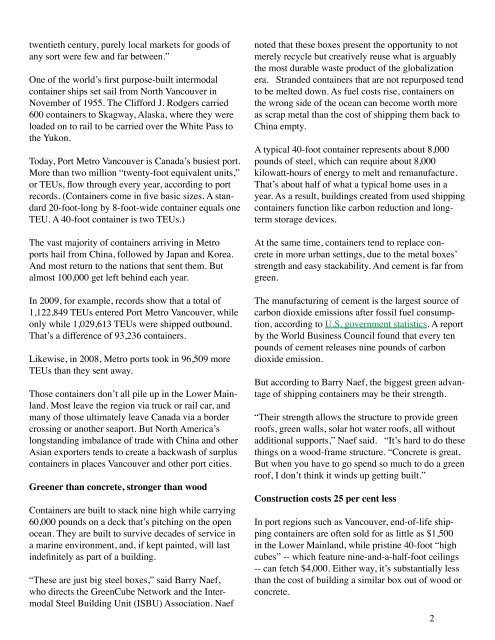from the ground up - The Tyee
from the ground up - The Tyee
from the ground up - The Tyee
Create successful ePaper yourself
Turn your PDF publications into a flip-book with our unique Google optimized e-Paper software.
twentieth century, purely local markets for goods ofany sort were few and far between.”One of <strong>the</strong> world’s first purpose-built intermodalcontainer ships set sail <strong>from</strong> North Vancouver inNovember of 1955. <strong>The</strong> Clifford J. Rodgers carried600 containers to Skagway, Alaska, where <strong>the</strong>y wereloaded on to rail to be carried over <strong>the</strong> White Pass to<strong>the</strong> Yukon.Today, Port Metro Vancouver is Canada’s busiest port.More than two million “twenty-foot equivalent units,”or TEUs, flow through every year, according to portrecords. (Containers come in five basic sizes. A standard20-foot-long by 8-foot-wide container equals oneTEU. A 40-foot container is two TEUs.)<strong>The</strong> vast majority of containers arriving in Metroports hail <strong>from</strong> China, followed by Japan and Korea.And most return to <strong>the</strong> nations that sent <strong>the</strong>m. Butalmost 100,000 get left behind each year.In 2009, for example, records show that a total of1,122,849 TEUs entered Port Metro Vancouver, whileonly while 1,029,613 TEUs were shipped outbound.That’s a difference of 93,236 containers.Likewise, in 2008, Metro ports took in 96,509 moreTEUs than <strong>the</strong>y sent away.Those containers don’t all pile <strong>up</strong> in <strong>the</strong> Lower Mainland.Most leave <strong>the</strong> region via truck or rail car, andmany of those ultimately leave Canada via a bordercrossing or ano<strong>the</strong>r seaport. But North America’slongstanding imbalance of trade with China and o<strong>the</strong>rAsian exporters tends to create a backwash of surpluscontainers in places Vancouver and o<strong>the</strong>r port cities.Greener than concrete, stronger than woodContainers are built to stack nine high while carrying60,000 pounds on a deck that’s pitching on <strong>the</strong> openocean. <strong>The</strong>y are built to survive decades of service ina marine environment, and, if kept painted, will lastindefinitely as part of a building.“<strong>The</strong>se are just big steel boxes,” said Barry Naef,who directs <strong>the</strong> GreenCube Network and <strong>the</strong> IntermodalSteel Building Unit (ISBU) Association. Naefnoted that <strong>the</strong>se boxes present <strong>the</strong> opportunity to notmerely recycle but creatively reuse what is arguably<strong>the</strong> most durable waste product of <strong>the</strong> globalizationera. Stranded containers that are not repurposed tendto be melted down. As fuel costs rise, containers on<strong>the</strong> wrong side of <strong>the</strong> ocean can become worth moreas scrap metal than <strong>the</strong> cost of shipping <strong>the</strong>m back toChina empty.A typical 40-foot container represents about 8,000pounds of steel, which can require about 8,000kilowatt-hours of energy to melt and remanufacture.That’s about half of what a typical home uses in ayear. As a result, buildings created <strong>from</strong> used shippingcontainers function like carbon reduction and longtermstorage devices.At <strong>the</strong> same time, containers tend to replace concretein more urban settings, due to <strong>the</strong> metal boxes’strength and easy stackability. And cement is far <strong>from</strong>green.<strong>The</strong> manufacturing of cement is <strong>the</strong> largest source ofcarbon dioxide emissions after fossil fuel consumption,according to U.S. government statistics. A reportby <strong>the</strong> World Business Council found that every tenpounds of cement releases nine pounds of carbondioxide emission.But according to Barry Naef, <strong>the</strong> biggest green advantageof shipping containers may be <strong>the</strong>ir strength.“<strong>The</strong>ir strength allows <strong>the</strong> structure to provide greenroofs, green walls, solar hot water roofs, all withoutadditional s<strong>up</strong>ports,” Naef said. “It’s hard to do <strong>the</strong>sethings on a wood-frame structure. “Concrete is great.But when you have to go spend so much to do a greenroof, I don’t think it winds <strong>up</strong> getting built.”Construction costs 25 per cent lessIn port regions such as Vancouver, end-of-life shippingcontainers are often sold for as little as $1,500in <strong>the</strong> Lower Mainland, while pristine 40-foot “highcubes” -- which feature nine-and-a-half-foot ceilings-- can fetch $4,000. Ei<strong>the</strong>r way, it’s substantially lessthan <strong>the</strong> cost of building a similar box out of wood orconcrete.2








